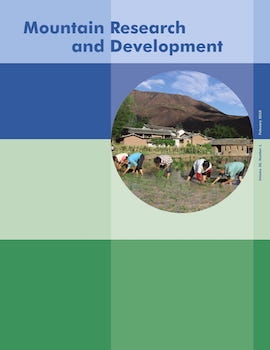Mountains: A Very Short Introduction by Martin F. Price. Oxford, United Kingdom: Oxford University Press, 2015. US$ 11.95, £ 7.99. ISBN 978-0-19-969588-1.
When a great deal has been written on a topic, it might be less challenging to add a new 300-page book than to write a very short and synthetic one. This is why the Oxford University Press “Very Short Introductions” collection of paperbacks deserves our attention. Each book within the list of the almost 450 titles published so far is between 120 and 180 pages long. Each strives to combine basic knowledge and the personal views of a writer who is well known in the relevant field. Between Mormonism and Muhammad lies number 444, soberly entitled Mountains. Its author, Martin Price, has already published numerous books about mountains. He also has played a pivotal role in building a global community of mountain scientists; recently he organized, for the third time in a decade, a meeting of this community in Scotland. In this context, the book can be said to be classical in terms of epistemology, representative of some major trends in scientific writing on mountains over the last 25 years, and, at the same time, original in the way it combines its components.
The book opens with a personal consideration of mountains—“an important part of my life” (p xv)—and then discusses the ever open question of the definition of mountains. Price reminds us of the surprising proposition made by Peattie in 1936, according to which one defining criterion of a mountain is that it strikes the imagination of the people living around it. But Price very quickly takes quite a different stance: Mountains are defined and qualified on an objective basis, and their cartography at the global scale provides the frame of reference for the whole analysis. In epistemic terms, the project is highly faithful to the scientific conception of mountains that has been dominant throughout the past three centuries (eg Debarbieux and Rudaz 2015).
Subsequently, much of the book aims at explaining how mountains are important for both the global ecosystem (water towers, biodiversity hotspots, etc) and human modes of living (mining, cultural values, etc). Here Price combines his academic expertise (based on global-scale data and illustrative examples) with personal convictions (“Why do mountains matter?”). This approach has been at the heart of efforts to mobilize scientists since the 1992 Earth Summit, where mountain advocates managed to bring attention to mountains during the conference and in Agenda 21. Since then Price has been one of the prominent scientists who persistently repeat why politicians, NGOs, and civil society should care about mountains, providing the factual elements on which this conviction is based.
The third main characteristic of this book lies in the original manner in which Price organizes his description. He has always been comfortable with broad synthesis, combining natural and human dimensions of mountain regions to underline similarities and differences between mountains in various parts of the globe. Readers will not find chapters devoted to the natural characterization of mountains followed by chapters successively filled with demographic, social, cultural, and political facts. Although the book sticks to a classical dualist ontology that contrasts nature with culture, all chapters combine natural and human characterizations, often in an original way. For example, a chapter whose heading—“Mountains are not eternal”—challenges the common-sense idea of mountains being there forever combines facts related to orogeny, erosion, natural risks, and mining; a chapter devoted to water analyzes the role of mountains in river regimes at the global scale but also describes the various techniques used to “harvest water” for irrigation and power generation. And a chapter headed “Centres of diversity” makes as much room for biodiversity as for cultural diversity. In a sense, the book strives to put at the very center of its multithematic description some transversal notions that make its content original.
This paperback book is indeed a “very short introduction” to mountains; but it is a good illustration of what is said on mountains nowadays in the academic world. And it offers real added value due to the personal qualities of the author.
REFERENCE
Notes
[1] A French version of this review was published by the Journal of Alpine Research / Revue de géographie alpine on its website: https://rga.revues.org/724.





